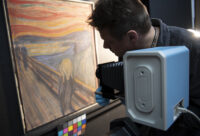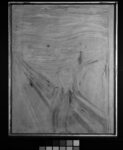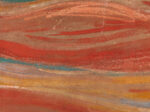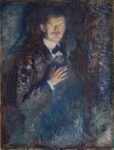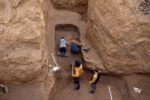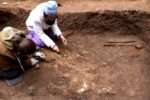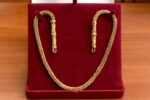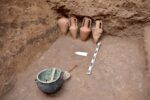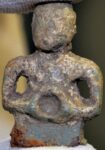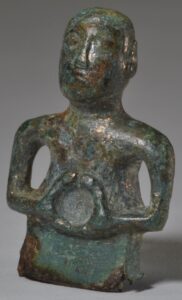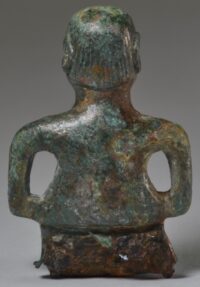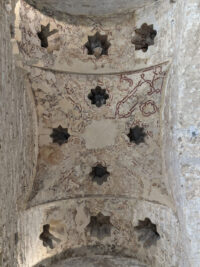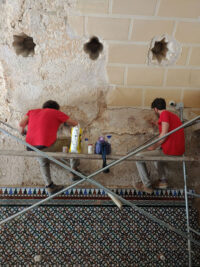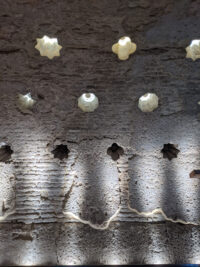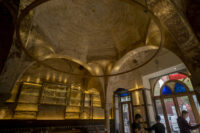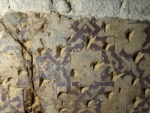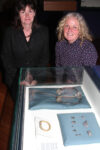 A hoard of jewelry from the Viking era found on the Isle of Man has been declared official Treasure. The objects are small in number but large in significance and one of them is large in the literal sense too.
A hoard of jewelry from the Viking era found on the Isle of Man has been declared official Treasure. The objects are small in number but large in significance and one of them is large in the literal sense too.
The hoard was discovered last December by Kath Giles, a retired police officer, while metal detecting on private land. The first thing she found when he brushed away the soil was a spherical terminal of a brooch. The rest of it — a long pin and a hoop — emerged next, followed by a braided gold arm ring and pieces of a broken silver armband.
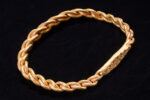 She notified Manx National Heritage and archaeologists identified the objects as Viking jewelry dating to around 950 A.D. Viking gold and silver jewelry have been found on the Isle of Man before, but this is the first time this type of gold arm-ring and brooch have been unearthed on the island.
She notified Manx National Heritage and archaeologists identified the objects as Viking jewelry dating to around 950 A.D. Viking gold and silver jewelry have been found on the Isle of Man before, but this is the first time this type of gold arm-ring and brooch have been unearthed on the island.
The gold arm ring is made of three thick rods of gold plaited together. The terminals are joined by flat band decorated with a stamped dot pattern. It was extremely valuable in the Viking era when gold artifacts are rare, worth the equivalent of 900 silver coins.
 The pin is a thistle brooch of ball type, named after the ball-shaped terminals and pin head with brambling decoration reminiscent of the bushy little flower. The brambling — tiny cones that just out from the cast silver ball — were created by making diagonal criss-cross cuts and then punching out some of them. The example in the hoard has incised designs along with the brambling on the head and terminals.
The pin is a thistle brooch of ball type, named after the ball-shaped terminals and pin head with brambling decoration reminiscent of the bushy little flower. The brambling — tiny cones that just out from the cast silver ball — were created by making diagonal criss-cross cuts and then punching out some of them. The example in the hoard has incised designs along with the brambling on the head and terminals.
It is a giant of a jewel, with the pin approximately 20 inches long and the hoop about eight inches in diameter. Originally a Celtic form of normal size, 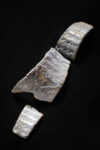 these types of penannular brooches were prized by the Vikings who settled in Ireland and put their own stamp on the Celtic design, greatly increasing their size and decreasing their decorative intricacy. They were signifiers of wealth and status, so the bigger the better, as far as the Vikings were concerned, even though it made them notably impractical as fasteners. Because of their massive size and weight, they could only have been worn on very thick outerwear like furs or skins. The pin was worn at the shoulder with the sharp point facing upwards.
these types of penannular brooches were prized by the Vikings who settled in Ireland and put their own stamp on the Celtic design, greatly increasing their size and decreasing their decorative intricacy. They were signifiers of wealth and status, so the bigger the better, as far as the Vikings were concerned, even though it made them notably impractical as fasteners. Because of their massive size and weight, they could only have been worn on very thick outerwear like furs or skins. The pin was worn at the shoulder with the sharp point facing upwards.
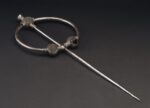 Allison [Fox, Curator for Archaeology for Manx National Heritage] said:
Allison [Fox, Curator for Archaeology for Manx National Heritage] said:
“Vikings arrived on the Isle of Man in the 800s, firstly trading and eventually settling. Kath’s hoard can be dated on stylistic and comparative grounds to around AD 950, a time when the Isle of Man was right in the middle of an important trading and economic zone. But elsewhere to the east and west, Viking rule was coming to an end and perhaps this encouraged further Viking settlement on the Island. The Viking and Norse influence remained strong on the Island for a further three hundred years, long after much of the rest of the British Isles.
The arm-ring, brooch and cut armband are all high-status personal ornaments and represent a large amount of accumulated wealth. Finding just one of these items would be of significance. The fact that all were found together, associated with one single deposition event, suggests that whoever buried them was extremely wealthy and probably felt immediately and acutely threatened.”
The hoard went on temporary display in the Viking and Medieval Gallery at the Manx Museum. It will be assessed by a committee of experts to determine its value and conserved before permanent display is arranged.
